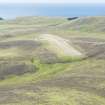Pricing Change
New pricing for orders of material from this site will come into place shortly. Charges for supply of digital images, digitisation on demand, prints and licensing will be altered.
Fair Isle, Burn Of Furse
Burnt Mound(S) (Prehistoric), Settlement(S) (Neolithic) - (Bronze Age)
Site Name Fair Isle, Burn Of Furse
Classification Burnt Mound(S) (Prehistoric), Settlement(S) (Neolithic) - (Bronze Age)
Canmore ID 3882
Site Number HZ27SW 3
NGR HZ 2172 7252
NGR Description HZ 2172 7252 and HZ 2180 7258
Datum OSGB36 - NGR
Permalink http://canmore.org.uk/site/3882
- Council Shetland Islands
- Parish Dunrossness
- Former Region Shetland Islands Area
- Former District Shetland
- Former County Shetland
HZ27SW 3 2172 7252 and 2180 7258
(HZ 2178 7258 and HZ 2170 7253) Tumulus (NR)
OS 6" map, Shetland, 2nd ed., (1903).
There are three mounds of burnt stones on the Burn of Furse near the bend of the roadway on the N side of Eas Becks.
RCAHMS 1946.
In the area centred HZ 217 725 two burnt mounds A and B,and two Neolithic/Bronze-Age houses C and D.
A - c.14.0m diameter, c.1.5m high, heavily quarried for road material (HZ 2172 7252).
B - c.8.0m diameter, c.1.2m high, hollowed in its centre (HZ 2180 7258). C - circular, 8.0m diameter with the remains of cells in the interior. Outside the entrance, in the SE, are traces of a forecourt c.6.0m diameter.
D - A circular hut foundation 7.5m diameter with a smaller annexe, 6.5m diameter, joined to its E side. Both are formed by stony banks heavily overgrown by peat and heather.
A scatter of stones at HZ 2165 7254 may be the remains of another Neolithic-Bronze Age house, but a small rectangular structure, now robbed, has stood on the site, making identification impossible.
Vague traces of field walls in the area, but heavily overgrown by peat and heather.
The third burnt mound referred to by RCAHMS may be one of the Neolithic/Bronze Age houses or a very small mound at HZ 2166 7260 in a bog. No trace of any burnt material in it. Possibly a clearance heap associated with 'C' and 'D', or a peat hag.
Visited by OS (RL) 1 June 1968.
Scheduled with HZ27SW 188, HZ27SW 189, HZ27SW 190, HZ27SW 224 as 'Burn of Furse to Homis Dale, settlement and burnt mounds, Fair Isle'.
Information from Historic Scotland, scheduling document dated 23 December 1996.
Field Visit (19 August 1930)
Burn of Furse. There are three burnt mounds on the Burn of Furse near the bend of the roadway on the N. side of Eas Brecks.
RCAHMS 1946, visited 19 August 1930
OS 6" map, Shetland, 2nd ed.,(1903) ‘Tumulus’, ‘Tumulus’ and unnoted.
Field Visit (1 June 1968)
In the area centred HZ 217 725 two burnt mounds A and B,and two Neolithic/Bronze-Age houses C and D.
A - c.14.0m diameter, c.1.5m high, heavily quarried for road material (HZ 2172 7252).
B - c.8.0m diameter, c.1.2m high, hollowed in its centre (HZ 2180 7258).
C - circular, 8.0m diameter with the remains of cells in the interior. Outside the entrance, in the SE, are traces of a forecourt c.6.0m diameter.
D - A circular hut foundation 7.5m diameter with a smaller annexe, 6.5m diameter, joined to its E side. Both are formed by stony banks heavily overgrown by peat and heather.
A scatter of stones at HZ 2165 7254 may be the remains of another Neolithic-Bronze Age house, but a small rectangular structure, now robbed, has stood on the site, making identification impossible.
Vague traces of field walls in the area, but heavily overgrown by peat and heather.
The third burnt mound referred to by RCAHMS may be one of the Neolithic/Bronze Age houses or a very small mound at HZ 2166 7260 in a bog. No trace of any burnt material in it. Possibly a clearance heap associated with 'C' and 'D', or a peat hag.
Visited by OS (RL) 1 June 1968.
Field Visit (1985)
Burnt mound c. 8.5 m in diameter and maximum height c. 1.5 m. Centre quarried to diameter of c. 3.5 m and depth c. 1 m. As result of quarrying highest point located to the N side. Burnt stones exposed in S face. RCAHMS 1946
Site 295.
Hunter, JR 1985




















